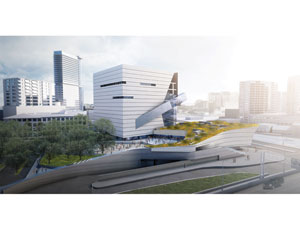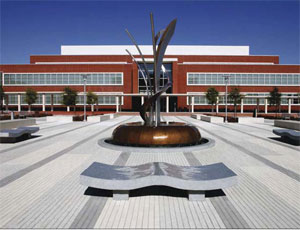In response to the financial challenges facing the Bay Area city of Richmond, city leaders decided not to replace its aging City Hall buildings and instead restore them as a symbol of hope for the future of its citizens.


The $78-million Richmond Civic Center Revitalization is a multi-phased design-build project that includes three buildings and a plaza. Phase one consisted of the seismic upgrade/building envelope repair/interior renovation to Richmond City Hall, seismic upgrade/building envelope repair/interior renovation to the existing Hall of Justice, seismic upgrade/building envelope repair and limited interior renovation to auditorium and plaza restoration and site work.
Prior to the renovation of the Civic Center, the 50-year-old City Hall, former Hall of Justice and auditorium buildings were in dire need of attention. Richmond is surrounded by multiple fault zones. The 1989 Loma Prieta earthquake, coupled with substantial sub-grade waterproofing issues at City Hall, indicated the need for a major renovation.
In fact, years before a construction contract was awarded, the city was forced to vacate the centrally-located City Hall and move its facilities across town.
By choosing to renovate and return to the existing Civic Center, the city has declared its desire to serve the citizens of Richmond from a more central location.
By incorporating high profile finishes and state-of-the-art energy, security and audio/visual components, the City Hall and former Hall of Justice provided a safer, more productive work environment. In addition, the proximity of the various city operations departments directly facilitates internal communication, thereby improving inter-department synergy. These updated facilities also act as a one-stop shop for the public by providing convenient access to all City departments and resources in a single location.
The Richmond Civic Center Revitalization project was awarded through a city-held competition for development teams using a design-build project delivery system.
In the early stages of planning and design, it was decided that the civic center would embrace and implement an environmentally sustainable design. The Richmond City Hall and Community Services Building were originally intended to achieve LEED silver certification. Ultimately, however, the design team submitted several additional LEED credits for each building and the USGBC awarded the project LEED gold certification.
Among the sustainable designs and implementations used were solar photovoltaic panels, water efficient landscaping, water use reduction, construction waste recycling and the use of green interior finish products.
Building information modeling software was used to model the existing footings of the Richmond City Hall and the Community Services Building. This proved to be very useful during the subgrade excavation operations.
Exposed structure as architectural elements exposing the existing concrete ceilings, columns and walls, along with new steel seismic braces, provides an open work environment. Widely-spaced suspended acoustical ceiling clouds maintained this exposed structural concept while providing acoustical and lighting properties appropriate for an office environment.
The project itself provided several hands-on opportunities for members of the community. The project team encouraged community involvement by hiring locally, awarding work to local subcontractors and offering youth scholarship programs. The percentage of local hires working on the job did not drop below 20% and at one time was as high as 35%. In order to accomplish this, the team worked closely with Richmond BUILD. Richmond BUILD is a pre-apprenticeship program that was developed to create employment and career opportunities for Richmond residents and thereby help reduce the potential for violence in the community.
To further support the community, portions of work were awarded to local contractors and artists. For example, Richmond-based contractor C. Overaa & Co. Construction was awarded the prime contract for the City Hall building while local Richmond artists John Wehrle and Archie Held largely contributed to the project.
From the earliest planning stages, the project design team understood there would be construction challenges associated with renovating an existing Civic Center that had been subjected to 50 years of settlement, chemical weathering and seismic activity. However, there was no way to assess the existing structural conditions until demolition could be performed.
The interior, non-structural elements of the City Hall and former Hall of Justice were demolished and removed. During this phase of work, it became clear just how out-of-plumb the buildings were. As the various seismic upgrades were installed at each building, additional work was required throughout the project to ensure all surfaces were level and plumb for the installation of finishes.
In an attempt to preserve the historical look of the buildings, the construction team was often faced with matching newly installed finishes with the retained existing finishes. For example, although the existing terrazzo floors were to be demolished, the central stairway of the City Hall was an area that was deemed historical and selected to remain generally untouched throughout construction. This area contained terrazzo steps and wall panels and was bordered by a wooden handrail. The specialty terrazzo contractor was required to install new terrazzo floors that closely resembled the old existing terrazzo floors and the retained stairway terrazzo.
Located on the first floor of the former Hall of Justice, the City Council Chamber contains a level of detail of the utmost quality and craftsmanship. The feature most notable upon first entering the Council Chamber is the 10-ft-high “Birds Eye View” mural of the city of Richmond recessed within a partition wall encased in fabric wrapped panels. Opposite the wall, open floor space allows for general seating and leads directly to the City Council Member dais. The stateliness of the Council Chamber is a prime example of the professional, efficient and first class efforts put forth by the construction team.
Project Team
Owner: City of RichmondDeveloper: Richmond Civic Center Partners, LLC (Alliance Property Group and The Wasatch Group, Los Angeles)
General Contractor: Charles Pankow Builders, Ltd., Oakland
Architects: Nadel Architects (building design), Los Angeles; WRT Design (landscape), San Francisco
City Hall Contractor: C. Overaa & Co., Richmond
Construction Manager: Mack 5, Emeryville
Structural Engineer: The KPA Group, Oakland
Civil Engineer: KPFF Consulting Engineers, San Francisco
Electrical Consultant: Contra Costa Electric, Martinez
Plumbing: L.J. Kruse, Berkeley
HVAC: ACCO, San Leandro

Post a comment to this article
Report Abusive Comment